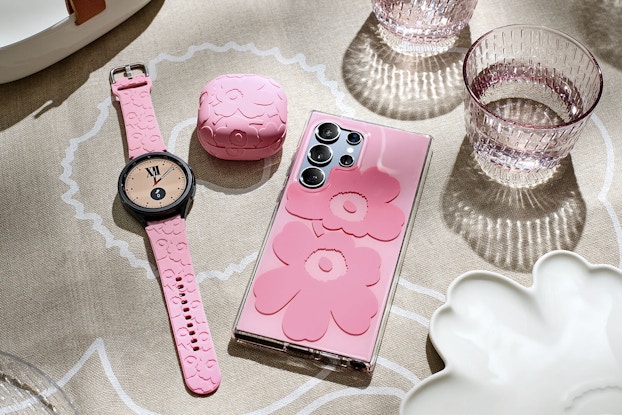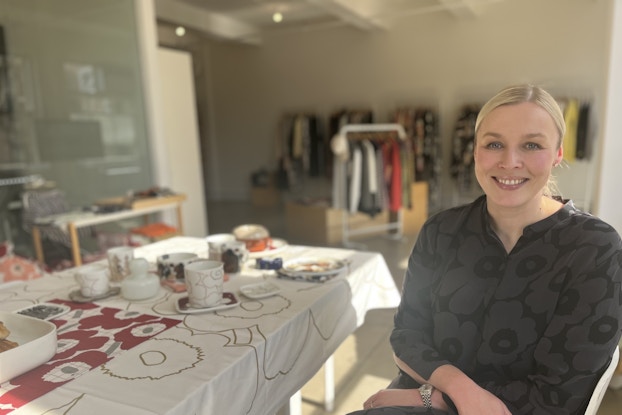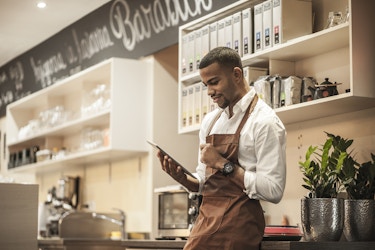
Why it matters:
- Finnish design house Marimekko made a splash in the U.S. market after former first lady and style icon Jackie Kennedy Onassis donned the brand’s boldly patterned dresses in the 1960s, earning an art-meets-commerce cachet over the decades that’s resulted in exclusive apparel and home collections with brands from Target to IKEA.
- The global brand is now making a bold bid for the U.S. market and younger consumers by leaning into its 73-year-old brand ethos, an ‘anti-fashion’ policy that favors individuality, inclusivity, and timeless, sustainable design — values that reflect the consumption habits of millennials and Gen Z, says CEO Tiina Alahuhta-Kasko.
- Marimekko is leveraging the 60th anniversary celebration this year of its signature Unikko abstract floral print to help fuel its U.S. growth strategy, which includes an apparel line at Nordstrom, its first-ever denim collection, and partnerships with influencers to introduce the brand to a whole new generation of consumers.
It’s a design motif that’s inspired exclusive apparel, home, and accessories collections with big brands like Target, IKEA, and Samsung.
The Unikko abstract floral print is instant shorthand for Marimekko, the Finnish design house that first lady and style icon Jackie Kennedy Onassis put on American consumers’ fashion radar in the 1960s when she turned up sporting the brand’s vibrantly patterned dresses.
Now celebrating the 60th anniversary of its iconic hero print “lays the strong foundation for our big brand moment,” as Marimekko courts a new generation of U.S shoppers, Tiina Alahuhta-Kasko, CEO of the global brand, told CO— from the company’s New York City offices.
Courting millennials and Gen Z means leaning into precisely what Marimekko has championed for 73 years — just with an updated twist, she said. “The mission of the brand has always been to empower people to be happy as they are and bring joy to their everyday life through our bold prints and colors,” she said. “We’ve evolved the product to be even more relevant to the local consumer.”
It’s all part of Marimekko’s U.S. expansion binge, which includes its first-ever (Unikko printed and sustainable) denim collection; an apparel line at Nordstrom; more limited-edition collaborations with brands like IKEA and Adidas; and partnerships with influencers who have a firm footing in the design world.
The idea is to make a bold splash in the lucrative American market and “phenomenalize” the brand that’s long prized “inclusivity and encouraging people to free their own personality through the way they dress themselves and their homes” — which happens to echo the values of today’s younger consumers, Alahuhta-Kasko said.
‘Marimekko is extremely topical to the next generation of consumers’
“We’ve always been an antidote to the sometimes superficial, exclusionary, status-symbol fashion world,” said Alahuhta-Kasko, who joined the company 20 years ago as an intern when she was in business school.
Marimekko formally enshrined that “anti-fashion” stance into its brand policy back in 1953, according to Scandinavian Design.
“If you think Marimekko is fashion, you’re lost. Marimekko is freedom from fashion — actually, a big laugh at establishmentarianism,” Armi Ratia, who founded the brand in 1951, once said, as reported in “Marimekko: The Art of Printmaking.” “I make a dress for women to live in.”
Indeed, the brand has long espoused functionality, sustainability, and long-lasting, timeless design — “We don’t want to exhaust the world with too many things”— Alahuhta-Kasko said, mirroring the consumption habits of millennials and Gen Z.
Gen Z, which boasts $360 billion in spending power in the U.S., prizes “authenticity and truth” and takes a “purpose-driven approach to consumption,” according to a report by trend forecaster WGSN.
And their older cohort millennials, who make up 80% of U.S. parents with children under 12, expect companies to reflect their eco-conscious values “and desire for their little ones to live in a diverse and inclusive world,” according to the WGSN report “Brand Strategy: Marketing to Midlife Millennials.”
Marimekko, for its part, draws “conscious consumers and walkers of their own path in life,” said Alahuhta-Kasko. “While we have a lot of brand love in the U.S. market, we want to widen our audience, and Marimekko is extremely topical to the next generation of consumers.”
[Read: Future Shop: Retail Innovations That Will Change How Consumers Spend in 2024 and Beyond]
Marimekko, for its part, draws “conscious consumers and walkers of their own path in life,” said Alahuhta-Kasko. “While we have a lot of brand love in the U.S. market, we want to widen our audience, and Marimekko is extremely topical to the next generation of consumers.”
Contemporizing the brand while guarding its design integrity: ‘We think of Marimekko as wearing art’
After navigating a tough pandemic landscape when the business retrenched, Marimekko is now building on its 2023 revival in North America, which includes the U.S. and Canada, where sales rose 20% to 9.57 million euros ($10.28 million U.S. dollars) from 2022.
Marimekko Creative Director Rebekka Bay, a retail veteran who’s served stints at merchants including Gap and DTC brand Everlane, has been critical to making the brand “globally coherent but locally relevant,” Alahuhta-Kasko said.
Bay has put a forward-looking spin on its Nordic, free-spirited design aesthetic while preserving its essence.
Its Kioski unisex streetwear line, for example, brings Marimekko’s signature prints to casual loungewear, “venturing into different lifestyle categories tailored for younger generations,” she said.
The updates have paid off.
“We have found quite a nice success recipe translating this original, differentiating brand DNA in a modern, contemporary way across our international markets,” Alahuhta-Kasko said. “And that’s why our next phase is all about scaling up our growth.”
Today, Marimekko boasts 3,500 prints and counting as it continues to add to its roster of artists who’ve always come from a variety of disciplines. “They might be painters, industrial designers,” Alahuhta-Kasko said.
Just as evolving Marimekko is key to acquiring new customers, guarding the artistic integrity of its design legacy is a point of pride for the brand. “We think of Marimekko as wearing art,” she said.
When Marimekko’s design team devises an updated take on Unikko, which will emblazon everything from a new silver jewelry line to hand-tufted area rugs this year amid a slew of anniversary-marking products, they consult the granddaughter of Maija Isola, who created the classic print and more than 500 others for Marimekko (including staples like the Mansikka strawberry and Kivet black circles prints) to ensure that it retains the integrity of the original design.
And while Marimekko holds the exclusive commercial rights to the prints, “the designers always keep the copyright,” Alahuhta-Kasko said.
[Read: How Slow Fashion Is Creating Opportunities for Startups and Legacy Brands Alike]
‘Wholesale is about introducing our brand to entirely new customers’
Wholesale fueled Marimekko’s North American growth last year and it’s investing further in that business via an apparel collection that launched in five Nordstrom stores this spring. The Nordstrom collection marks a bold step in expanding Marimekko's wholesale presence in the U.S., Alahuhta-Kasko said. Wholesale is about “widening our reach, presence, acquiring new customers, and introducing our brand entirely to new customers,” Alahuhta-Kasko said.
Marimekko’s August denim launch marks its first big product category expansion in years, adding “the missing piece” in its fashion mix as jeans are a staple, casual wardrobe item, she said.
With this move, the brand is also tapping into the $27.58 billion North American jeans market that’s literally woven into the fabric of U.S. culture, a mature business that’s nonetheless “booming,” according to a Modor Intelligence report, “as companies are introducing new and innovative products with sustainable fabrics to make their products unique from existing ones.”
For its part, Marimekko’s organic Maridenim jeans collection, which also comes in a laser-printed Unikko pattern, is made from 80% organic cotton and 20% recycled cotton. “This commitment to sustainability is really part of our design and business philosophies,” Alahuhta-Kasko said. “And of course, we see it’s increasingly important to the next generation.”

‘Influencers will play a key role in getting the word out there’
Influencers figure prominently into Marimekko’s strategy to reach younger consumers. “They’ll play a key role in getting the word out there,” she said.
They’ll whip up buzz for the brand in the U.S. as it fetes Unikko’s 60th birthday this year and beyond; help forge community with consumers on social platforms like Instagram and via live events; and hopefully stoke their impulse to make Marimekko fashion and home goods their own, Alahuhta-Kasko said.
But those influencers have “got to be a creative voice,” with concrete ties to the world of art and design, she said.
Marimekko is partnering with artists like Jade Purple Brown, whose work includes art installations for Starbucks and packaging design for Clinique, and fashion illustrator/jewelry designer Jenny Walton, who hosted a vintage pop-up shopping event complete with a DJ and snacks at Marimekko’s Manhattan SoHo store during New York Fashion Week that spotlighted the brand’s legacy prints.
In-store events and brand activations will “build these physical connections, inspiration, brand culture, and community,” she said.
Marimekko is also betting big on its buzzy limited-edition collaborations to awaken younger consumers to the brand and accelerate growth in the U.S. market.
In 2023, the company generated record high licensing income worldwide, fueled in part by partnerships like those with IKEA and Adidas. This year a collaboration with Japanese retailer UNIQLO on a winter collection brought items like Kivet-patterned fleece jackets and turtlenecks to U.S. consumers.
“Brand collaborations are a really important part of our strategy,” Alahuhta-Kasko said. They “introduce the brand to new customers and support the growth story holistically.”
CO— aims to bring you inspiration from leading respected experts. However, before making any business decision, you should consult a professional who can advise you based on your individual situation.
CO—is committed to helping you start, run and grow your small business. Learn more about the benefits of small business membership in the U.S. Chamber of Commerce, here.
CO— Exclusives: Insider Strategies
How the buzziest brands and hottest startups are solving today's biggest business challenges. CO— brings you advice from startup founders and top executives for thriving in a new world.








